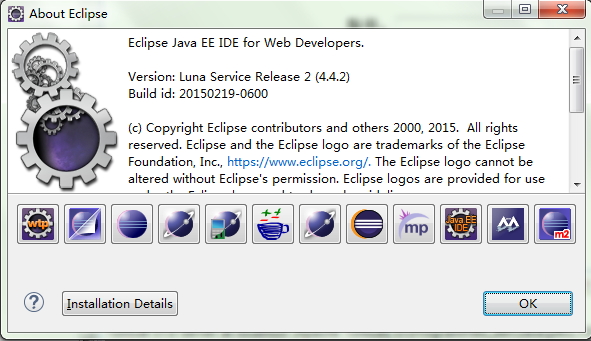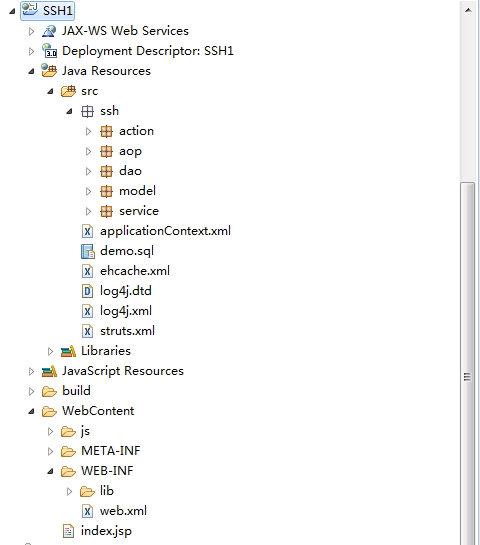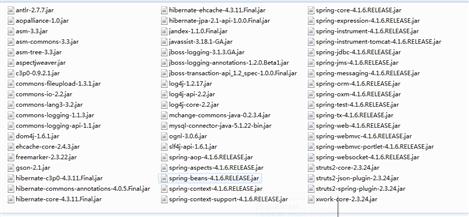struts2.3.24 + spring4.1.6 + hibernate4.3.11 + mysql5.5.25开发环境搭建及相关说明
Posted
tags:
篇首语:本文由小常识网(cha138.com)小编为大家整理,主要介绍了struts2.3.24 + spring4.1.6 + hibernate4.3.11 + mysql5.5.25开发环境搭建及相关说明相关的知识,希望对你有一定的参考价值。
一、目标
1、搭建传统的ssh开发环境,并成功运行(插入、查询)
2、了解c3p0连接池相关配置
3、了解验证hibernate的二级缓存,并验证
4、了解spring事物配置,并验证
5、了解spring的IOC(依赖注入),将struts2的action对象(bean)交给spring管理,自定义bean等...并验证
6、了解spring aop(面向切面编程),并编写自定义切面函数,验证结果
二、前期准备
开发环境:eclipse for java ee;mysql5.5.25;jdk1.7.0_79;navicat10.1.7(可选);

创建数据库demo:
/* Navicat mysql Data Transfer Source Server : localhost_3306 Source Server Version : 50519 Source Host : localhost:3306 Source Database : demo Target Server Type : MYSQL Target Server Version : 50519 File Encoding : 65001 Date: 2016-01-09 23:36:02 */ SET FOREIGN_KEY_CHECKS=0; -- ---------------------------- -- Table structure for `user` -- ---------------------------- DROP TABLE IF EXISTS `user`; CREATE TABLE `user` ( `id` bigint(20) NOT NULL AUTO_INCREMENT, `account` varchar(200) NOT NULL, `name` varchar(200) NOT NULL, `address` varchar(1000) NOT NULL, PRIMARY KEY (`id`) ) ENGINE=InnoDB DEFAULT CHARSET=utf8;
新建web工程,目录结构如下:

jar包准备,放到WEB-INF的lib目录下(有兴趣的可以用maven管理过程,但是有时候下载jar包很慢...)
相关jar包都可以在下载下来的struts、spring、hibernate中找到,这里给个参考,有些是可以删除的,比如spring mvc部分的jar包:

三、配置web.xml
- 配置一个struts2的filter,映射所有*.action请求,由StrutsPrepareAndExecuteFilter对象来处理;
- 配置context-param参数,指定spring配置文件的路径,<context-param>中的参数可以用ServletContext.getInitParameter(“param-name”)来获取;
- 配置listener,主要是读取applicationContext.xml配置文件信息,创建bean等初始化工作;
<?xml version="1.0" encoding="UTF-8"?> <web-app xmlns:xsi="http://www.w3.org/2001/XMLSchema-instance" xmlns="http://java.sun.com/xml/ns/javaee" xsi:schemaLocation="http://java.sun.com/xml/ns/javaee http://java.sun.com/xml/ns/javaee/web-app_3_0.xsd" id="WebApp_ID" version="3.0"> <display-name>SSH</display-name> <filter> <filter-name>struts2</filter-name> <filter-class>org.apache.struts2.dispatcher.ng.filter.StrutsPrepareAndExecuteFilter</filter-class> </filter> <filter-mapping> <filter-name>struts2</filter-name> <url-pattern>*.action</url-pattern> </filter-mapping> <context-param> <param-name>contextConfigLocation</param-name> <param-value>classpath:applicationContext.xml</param-value> </context-param> <listener> <listener-class>org.springframework.web.context.ContextLoaderListener</listener-class> </listener> <welcome-file-list> <welcome-file>index.jsp</welcome-file> </welcome-file-list> </web-app>
四、配置applicationContext.xml
- 配置自动扫描ssh包下的@Repostory,@Service等注解,并生成对应的bean;
- 配置数据源(jdbc连接池为c3p0,可以参考c3p0的详细配置),连接池主要作用是快速提供connection,重复利用,不需要每次销毁创建,需配置用户名、密码、最大连接数、最小连接数、初始连接数等相关参数;
- 配置sessionFactory(可以参考hibernate的详细配置,这里配置开启二级缓存),主要作用是提供session,执行sql语句;这里我们将会通过HibernateTemplate来对数据库进行操作,方便spring进行实物控制;ps,hibernate配置中还要配置类与数据库表的映射;
- 配置事务管理器bean为HibernateTransactionManager,并把成员属性sessionFactory初始化为之前配置的sessionFactory bean;
- 配置事务的传播特性,并配置一个切面引用它,对所有ssh.service包及子包下所有add、delete、update、save方法进行事务控制,还可以配置事务传播行为等参数;
- 最后是一个自定义aop相关配置,对ssh.aop.AopTest下所有test开头的方法应用自定义切面‘myAop’进行控制,后续会验证结果;
<?xml version="1.0" encoding="UTF-8"?> <beans xmlns="http://www.springframework.org/schema/beans" xmlns:p="http://www.springframework.org/schema/p" xmlns:context="http://www.springframework.org/schema/context" xmlns:tx="http://www.springframework.org/schema/tx" xmlns:xsi="http://www.w3.org/2001/XMLSchema-instance" xmlns:aop="http://www.springframework.org/schema/aop" xmlns:jdbc="http://www.springframework.org/schema/jdbc" xsi:schemaLocation=" http://www.springframework.org/schema/beans http://www.springframework.org/schema/beans/spring-beans.xsd http://www.springframework.org/schema/aop http://www.springframework.org/schema/aop/spring-aop.xsd http://www.springframework.org/schema/tx http://www.springframework.org/schema/tx/spring-tx-4.1.xsd http://www.springframework.org/schema/jdbc http://www.springframework.org/schema/jdbc/spring-jdbc-4.1.xsd http://www.springframework.org/schema/context http://www.springframework.org/schema/context/spring-context-4.1.xsd"> <!-- scans the classpath for annotated components (including @Repostory and @Service that will be auto-registered as Spring beans --> <context:component-scan base-package="ssh" /> <!--配数据源 --> <bean name="dataSource" class="com.mchange.v2.c3p0.ComboPooledDataSource" destroy-method="close"> <property name="driverClass" value="com.mysql.jdbc.Driver" /> <property name="jdbcUrl" value="jdbc:mysql://localhost:3306/demo" /> <property name="user" value="root" /> <property name="password" value="root" /> <property name="acquireIncrement" value="1"></property> <property name="initialPoolSize" value="80"></property> <property name="maxIdleTime" value="60"></property> <property name="maxPoolSize" value="80"></property> <property name="minPoolSize" value="30"></property> <property name="acquireRetryDelay" value="1000"></property> <property name="acquireRetryAttempts" value="60"></property> <property name="breakAfterAcquireFailure" value="false"></property> <!-- 如出现Too many connections, 注意修改mysql的配置文件my.ini,增大最多连接数配置项,(查看当前连接命令:show processlist) --> </bean> <bean id="sessionFactory" class="org.springframework.orm.hibernate4.LocalSessionFactoryBean"> <property name="dataSource" ref="dataSource" /> <property name="hibernateProperties"> <props> <prop key="hibernate.dialect">org.hibernate.dialect.MySQLDialect</prop> <prop key="hibernate.show_sql">true</prop> <prop key="hibernate.hbm2ddl.auto">update</prop> <prop key="current_session_context_class">thread</prop> <prop key="hibernate.cache.use_second_level_cache">true</prop> <prop key="hibernate.cache.region.factory_class">org.hibernate.cache.ehcache.EhCacheRegionFactory</prop> <prop key="hibernate.cache.use_query_cache">true</prop> <prop key="hibernate.cache.provider_configuration_file_resource_path">ehcache.xml</prop> </props> </property> <property name="mappingLocations"> <list> <value>classpath:ssh/model/User.hbm.xml</value> </list> </property> <!-- <property name="annotatedClasses"> <list> <value>ssh.model.User</value> </list> </property> --> </bean> <!-- 配置事务管理器 --> <bean id="transactionManager" class="org.springframework.orm.hibernate4.HibernateTransactionManager"> <property name="sessionFactory" ref="sessionFactory" /> </bean> <!-- 事务的传播特性 --> <tx:advice id="txadvice" transaction-manager="transactionManager"> <tx:attributes> <tx:method name="add*" propagation="REQUIRED" read-only="false" rollback-for="java.lang.Exception"/> <tx:method name="delete*" propagation="REQUIRED" read-only="false" rollback-for="java.lang.Exception"/> <tx:method name="update*" propagation="REQUIRED" read-only="false" rollback-for="java.lang.Exception"/> <tx:method name="save*" propagation="REQUIRED" read-only="false" rollback-for="java.lang.Exception"/> </tx:attributes> </tx:advice> <aop:config> <aop:pointcut id="pcMethod" expression="execution(* ssh.service..*.*(..))" /> <aop:advisor pointcut-ref="pcMethod" advice-ref="txadvice" /> </aop:config> <!-- 自定义aop处理 测试 --> <bean id="aopTest" class="ssh.aop.AopTest"></bean> <bean id="myAop" class="ssh.aop.MyAop"></bean> <aop:config proxy-target-class="true"> <aop:aspect ref="myAop"> <aop:pointcut id="pcMethodTest" expression="execution(* ssh.aop.AopTest.test*(..))"/> <aop:before pointcut-ref="pcMethodTest" method="before"/> <aop:after pointcut-ref="pcMethodTest" method="after"/> </aop:aspect> </aop:config> </beans>
五、配置struts.xml
配置struts.objectFactory常数为spring,表示action由通过spring的bean中获取;
配置result type为"json",也可以配置其它的,这里为了前后端数据交互简便,配置成json格式;
配置两个action,addUser和queryAllUser;
<?xml version="1.0" encoding="UTF-8" ?> <!DOCTYPE struts PUBLIC "-//Apache Software Foundation//DTD Struts Configuration 2.3//EN" "http://struts.apache.org/dtds/struts-2.3.dtd"> <struts> <constant name="struts.objectFactory" value="spring"/> <constant name="struts.enable.DynamicMethodInvocation" value="false" /> <constant name="struts.devMode" value="false" /> <package name="default" extends="struts-default,json-default"> <global-results> <result type="json"> <param name="root">json</param> <param name="contentType">text/html</param> </result> </global-results> <action name="addUser" class="userAction" method="addUser"> <result>.</result> </action> <action name="queryAllUser" class="userAction" method="queryAllUser"> <result>.</result> </action> </package> <!-- Add packages here --> </struts>
六、编写相关代码
注意事项:
dao继承HibernateDaoSupport类,所有数据库相关操作用hibernateTemplate操作;
给dao层,service层,action添加相应注解,注册为spring的bean;
附代码如下:
UserAction.java

package ssh.action; import java.io.PrintWriter; import java.util.List; import javax.annotation.Resource; import javax.servlet.http.HttpServletRequest; import javax.servlet.http.HttpServletResponse; import org.apache.log4j.Logger; import org.apache.struts2.ServletActionContext; import org.springframework.stereotype.Controller; import ssh.aop.AopTest; import ssh.model.User; import ssh.service.UserService; import com.google.gson.Gson; @Controller public class UserAction { Logger logger = Logger.getLogger(UserAction.class); @Resource private UserService userService; @Resource private AopTest aopTest; public void addUser(){ PrintWriter out = null; try{ HttpServletRequest request = ServletActionContext.getRequest(); HttpServletResponse response = ServletActionContext.getResponse(); response.setContentType("text/html;charset=UTF-8"); String account = request.getParameter("account"); String name = request.getParameter("name"); String address = request.getParameter("address"); User user = new User(); user.setAccount(account); user.setAddress(address); user.setName(name); userService.add(user); out = response.getWriter(); out.write(new Gson().toJson("success")); }catch(Exception e){ e.printStackTrace(); logger.error(e.getMessage()); if(out != null) out.write(new Gson().toJson("fail")); }finally{ out.flush(); out.close(); } } public void queryAllUser(){ PrintWriter out = null; aopTest.test1(); aopTest.test2(); //logger.error("i"); try { HttpServletResponse response = ServletActionContext.getResponse(); response.setContentType("text/html;charset=UTF-8"); Gson gson = new Gson(); List<User> userList= userService.queryAllUser(); String gsonStr = gson.toJson(userList); out = response.getWriter(); out.write(gsonStr); } catch (Exception e) { e.printStackTrace(); logger.error(e.getMessage()); if(out != null) out.write(new Gson().toJson("fail")); }finally{ out.flush(); out.close(); } } }
AopTest.java

package ssh.aop; public class AopTest { public void test1(){ System.out.println("AopTest test1 method is running~"); } public void test2(){ System.out.println("AopTest test2 method is running~"); } }
MyAop.java

package ssh.aop; public class MyAop { public void before(){ System.out.println("befor~"); } public void after(){ System.out.println("after~"); } }
BaseDao.java

package ssh.dao.base; import javax.annotation.Resource; import org.hibernate.SessionFactory; import org.springframework.orm.hibernate4.support.HibernateDaoSupport; public class BaseDao extends HibernateDaoSupport{ @Resource public void setMySessionFactory(SessionFactory sessionFactory){ this.setSessionFactory(sessionFactory); } }
UserDao.java

package ssh.dao; import java.util.ArrayList; import java.util.List; import org.springframework.orm.hibernate4.HibernateTemplate; import org.springframework.stereotype.Repository; import ssh.dao.base.BaseDao; import ssh.model.User; @Repository public class UserDao extends BaseDao{ public void add(User user){ this.getHibernateTemplate().save(user); } @SuppressWarnings("unchecked") public List<User> queryAllUser(){ List<User> users = new ArrayList<User>(); HibernateTemplate hibernateTemplate = this.getHibernateTemplate(); hibernateTemplate.setCacheQueries(true); users = (List<User>) hibernateTemplate.find("from User"); hibernateTemplate.setCacheQueries(false); return users; } }
User.java

package ssh.model; import java.io.Serializable; public class User implements Serializable{ /** * */ private static final long serialVersionUID = -6190571611246371934L; private Long id; private String account; private String name; private String address; public String getAccount() { return account; } public String getName() { return name; } public String getAddress() { return address; } public void setAccount(String account) { this.account = account; } public void setName(String name) { this.name = name; } public void setAddress(String address) { this.address = address; } /** * @return the id */ public Long getId() { return id; } /** * @param id the id to set */ public void setId(Long id) { this.id = id; } }
User.hbm.xml

<?xml version="1.0"?> <!-- ~ Hibernate, Relational Persistence for Idiomatic Java ~ ~ Copyright (c) 2010, Red Hat Inc. or third-party contributors as ~ indicated by the @author tags or express copyright attribution ~ statements applied by the authors. All third-party contributions are ~ distributed under license by Red Hat Inc. ~ ~ This copyrighted material is made available to anyone wishing to use, modify, ~ copy, or redistribute it subject to the terms and conditions of the GNU ~ Lesser General Public License, as published by the Free Software Foundation. ~ ~ This program is distributed in the hope that it will be useful, ~ but WITHOUT ANY WARRANTY; without even the implied warranty of MERCHANTABILITY ~ or FITNESS FOR A PARTICULAR PURPOSE. See the GNU Lesser General Public License ~ for more details. ~ ~ You should have received a copy of the GNU Lesser General Public License ~ along with this distribution; if not, write to: ~ Free Software Foundation, Inc. ~ 51 Franklin Street, Fifth Floor ~ Boston, MA 02110-1301 USA --> <!DOCTYPE hibernate-mapping PUBLIC "-//Hibernate/Hibernate Mapping DTD 3.0//EN" "http://www.hibernate.org/dtd/hibernate-mapping-3.0.dtd"> <hibernate-mapping package="ssh.model"> <class name="User" table="user"> <cache usage="read-write"/> <id name="id" column="id"> <generator class="increment"/> </id> <property name="account" type="java.lang.String" column="account"/> <property name="name" type="java.lang.String" column="name"/> <property name="address" type="java.lang.String" column="address"/> </class> </hibernate-mapping>
UserService.java

package ssh.service; import java.util.List; import javax.annotation.Resource; import org.springframework.stereotype.Service; import ssh.dao.UserDao; import ssh.model.User; @Service public class UserService { @Resource private UserDao userDao = new UserDao(); public List<User> queryAllUser(){ return userDao.queryAllUser(); } public void add(User user){ userDao.add(user); } }
index.jsp(记得添加jquery库)

<%@ page language="java" contentType="text/html; charset=UTF-8" pageEncoding=
